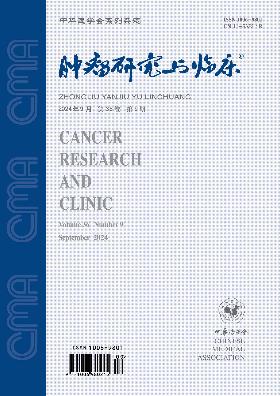Effect of apicidin on glioblastoma U87 cells and its regulation of OCT-4 gene expression
Q4 Medicine
引用次数: 0
Abstract
Objective To investigate the effect of histone deacetylase inhibitor apicidin on the glioblastoma U87 cells and its regulation of OCT-4 gene expression. Methods Glioblastoma U87 cells were treated with different concentrations of apicidin, and dimethyl sulfoxide instead of apicidin was negative control. Methyl thiazolyl tetrazolium (MTT) assay was used to detect the proliferative ability of U87 cells treated by apicidin. The cell apoptosis was observed under the fluorescence microscope, and the cell cycle was detected by using flow cytometry. Reverse transcription-polymerase chain reaction and Western blot was used to detect the expression of mRNA and protein of U87 cells, respectively relative to the expression of GAPDH. Results MTT assay results showed that apicidin inhibited U87 cells proliferation in a dose-dependent and time-dependent manner, and half of the inhibitory concentration of cell proliferation at 48 h was (1.74±0.13) μmol/L. The cell proportion of U87 cells in S-phase of the negative control, 0.2, 0.5, and 1.0 μmol/L apicidin was (32.68±0.49)%, (33.73±0.76)%, (42.92±0.56)%, and (56.95±0.53)%, respectively after 48 h apicidin administration (P < 0.05), while the proportion of G1 and G2 phase cells was decreased. The karyopyknosis and other apoptotic changes were detected in U87 cells after 48 h treatment of 1.0 μmol/L apicidin under the confocal fluorescence microscope. Western blot and RT-PCR showed that the mRNA and protein relative levels of U87 cells OCT-4 were reduced after 1.0 μmol/L apicidin treatment for 48 h compared with the negative control group (mRNA: 72.44±0.00 vs. 56.66±0.23; protein: 86.59±0.19 vs. 56.04±0.15, both P < 0.01). Conclusions Apicidin can inhibit the growth of glioblastoma U87 cells, induce cell cycle arrest and apoptosis. Its mechanism may be related to the expression of OCT-4 inhibited by apicidin. Key words: Glioma; Histone deacetylases; OCT-4; Epigenomicsapicidin对胶质母细胞瘤U87细胞的作用及其对OCT-4基因表达的调控
目的研究组蛋白去乙酰化酶抑制剂阿哌酸丁对胶质母细胞瘤U87细胞的作用及其对OCT-4基因表达的调控。方法用不同浓度的apicidin处理胶质母细胞瘤U87细胞,以二甲基亚砜代替apicidin为阴性对照。采用甲基噻唑四唑蓝(MTT)法检测apicidin对U87细胞的增殖能力。荧光显微镜下观察细胞凋亡,流式细胞仪检测细胞周期。采用逆转录聚合酶链式反应和蛋白质印迹法分别检测U87细胞的mRNA和蛋白质表达与GAPDH表达的关系。结果MTT法检测结果表明,apicidin对U87细胞增殖的抑制作用呈剂量依赖性和时间依赖性,48h时细胞增殖抑制浓度的一半为(1.74±0.13)μmol/L。阴性对照、0.2、0.5和1.0μmol/L apicidin的U87细胞在S期的细胞比例在给药48小时后分别为(32.68±0.49)%、(33.73±0.76)%,(42.92±0.56)%和(56.95±0.53)%(P<0.05),而G1期和G2期细胞的比例下降。μmol/L apicidin处理U87细胞48h后,在共聚焦荧光显微镜下观察到U87细胞核固缩和其他凋亡变化。Western blot和RT-PCR结果显示,与阴性对照组相比,1.0μmol/L apicidin处理48 h后U87细胞OCT-4的mRNA和蛋白相对水平降低(mRNA:72.44±0.00 vs.56.66±0.23;蛋白:86.59±0.19vs.56.04±0.15,均P<0.01)。其机制可能与apicidin抑制OCT-4的表达有关。关键词:胶质瘤;组蛋白脱乙酰酶;10月4日;表观基因组学
本文章由计算机程序翻译,如有差异,请以英文原文为准。
求助全文
约1分钟内获得全文
求助全文
来源期刊

肿瘤研究与临床
Medicine-Oncology
CiteScore
0.10
自引率
0.00%
发文量
7737
期刊介绍:
"Cancer Research and Clinic" is a series of magazines of the Chinese Medical Association under the supervision of the National Health Commission and sponsored by the Chinese Medical Association.
It mainly reflects scientific research results and academic trends in the field of malignant tumors. The main columns include monographs, guidelines and consensus, standards and norms, treatises, short treatises, survey reports, reviews, clinical pathology (case) discussions, case reports, etc. The readers are middle- and senior-level medical staff engaged in basic research and clinical work on malignant tumors.
 求助内容:
求助内容: 应助结果提醒方式:
应助结果提醒方式:


